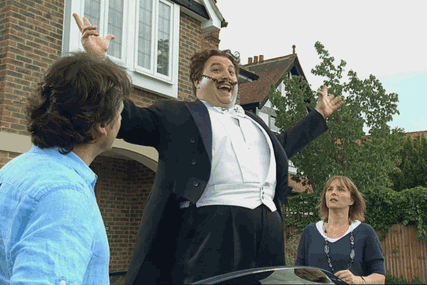LONDON – They may grab our attention and then worm their way into our subconscious, but some commercials are memorable for all the wrong reasons.

While 2009 may have been a tough 12 months for the industry, it was a vintage year for irritating ads.
The end of Kerry Katona’s contract with Iceland did remove one regular fixture from the annual list, but a host of other brands has joined the fray. The morbidly obese opera singer of the Gocompare ad propelled the brand into
the top spot of this year’s howlers.
It was closely followed by Cash4Gold – a company that has become one of the beneficiaries of the recession by encouraging impecunious consumers to trade in their trinkets for hard cash.
| Which commercials irritated you most in the past year? | |||
| Rank | Brand | Agency | % |
| 1 | Gocompare.com | In-house | 56 |
| 2= | Cash4Gold | Brian Buckley, Hungry Man Productions | 46 |
| 2= | Glade Touch ‘n’ Fresh | Draftfcb Argentina | 46 |
| 4 | Swiftcover | MWO | 40 |
| 5 | Confused.com | In-house | 38 |
| 6 | 118 247 | Rapier | 34 |
| 7= | Churchill | WCRS | 32 |
| 7= | Webuyanycar.com | In-house | 32 |
| 9= | Nintendo | Karmarama | 25 |
| 9= | Country Life | Grey London | 25 |
| 11 | McDonald’s | Leo Burnett | 24 |
| 12 | Kingsmill | M&C Saatchi | 22 |
| 13 | BT | Abbott Mead Vickers BBDO | 21 |
| 14 | Gillette | BBDO New York | 20 |
| 15= | T-Mobile | Saatchi & Saatchi | 18 |
| 15= | Peugeot | Euro RSCG London | 18 |
| 15= | Dolmio | Proximity London | 18 |
| 18 | Orange (Monkey) | Fallon London | 15 |
| 19= | Greggs | Propaganda | 14 |
| 19= | Tesco | The Red Brick Road | 14 |
| 21 | Holland & Barrett | WCRS | 13 |
| 22 | Pampers | Saatchi & Saatchi | 11 |
Adwatch research was conducted from 24-26 November 2009 by TNS. Prompted interviews took place via the internet. Sample of 1011 British adults aged 16-64 were interviewed.
As ever, many of the brands that top the list relish their most-irritating status. Nicholas Hall, head of marketing at Gocompare.com, says that, because the campaign is ‘not vanilla’ it has significantly boosted the price-comparison site’s profile. According to Gocompare’s own consumer research, there has been a 200% increase in awareness of the brand since the activity started in August.
One of the oldest truisms about marketing posits that the bigger the brand, the harder the fall. Those that have the biggest budgets and shout the loudest also run the greatest risk of offending consumers. However, while McDonald’s, Gillette and T-Mobile all make an appearance on this year’s list, smaller brands are punching above their weight when it comes to annoying consumers. Of particular note is the fact that three of the top 10 most-irritating ads were produced in-house by relatively new brands – Confused.com and Webuyanycar.com as well as Gocompare.com.
The question remains whether being irritating is a successful marketing strategy in itself. Proponents of this approach suggest that, like any strong response, irritation equates to awareness – the ultimate aim of all ad campaigns. However, Simon White, joint managing director of ad agency Grey London, points out that brands that have been accused of irritating consumers in the past – such as Cillit Bang and Radion – achieved a short-term spike in sales, but struggled to maintain this performance in the long term.
This view is echoed by Richard Huntington, director of strategy at Saatchi & Saatchi. He says that while these irritating ads are clearly memorable, whether they can form part of a sustainable communication strategy remains to be seen. Put simply, once a brand has done its best to irritate consumers it is difficult to see where the creative approach goes next.
Given the sharp rise in complaints to the Advertising Standards Authority, it could be argued that consumers are less tolerant of brands on the whole. Not so, according to Huntington. ‘People have become less tolerant of interruption but this is more to do with the entertainment on-demand culture,’ he says.
Yet, there has been a shift in advertising strategies during the downturn and many brands topping the list appear to have attended the Alan Sugar school of marketing; by asking their agencies to ‘work harder’ to help them stand out from the crowd they are effectively causing branding overkill, often through the medium of the jingle.
Andy Nairn, executive planning director of ad agency MCBD, believes that it is not enough for
ads simply to raise awareness if they are not well-liked. ‘Most people have an awareness of Josef Fritzl, but it doesn’t mean they want to spend time with him,’ he says.
Nairn points to the success of brands such as Hovis that have fostered a genuinely emotional connection to consumers rather than focusing on direct response. ‘The standard of advertising has dropped as marketers increasingly believe they are working hard through excessive brand awareness,’ he adds.
The last word goes to Gocompare.com’s Hall, who clearly believes it is better to be on the list than forgotten about. ‘I’d say that the campaign has performed exactly as we’d have hoped so far, and, I’m sure, better than many of those campaigns that weren’t memorable enough to make it into the list,’ he says. ‘However, as much as you’d like to, you can’t please all the people all of the time.’ Whether his brand’s activity pleases any of the people any of the time remains a moot point.
www.warren-knight.com thanks Marketing Magazine
